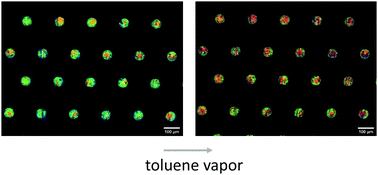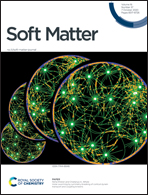Chameleon skin-inspired polymeric particles for the detection of toluene vapor†
Abstract
Inspired by the structural coloring in nature, especially the crystalline ordering and responsive characteristics of those found in chameleon skins, artificial photonic materials for sensor applications were fabricated. Cholesteric liquid crystals (CLCs) were employed in the templated synthesis of polymeric particles with periodic structures that allow visible light to undergo Bragg reflection and their response was tested against volatile organic compounds (VOCs). We demonstrate that the particles were responsive against toluene with detection limits on the order of 100 ppm. Such sensitivity was shown to be achieved due to the critical steps followed during the CLC-templated synthesis of particles that resulted in the storage of elastic energy in the anisotropic glassy polymer network. In addition, the design of particle-assisted sensor chips that allow easy integration into wearable optical devices for reliable, continuous and online tracking of VOC concentrations is presented. These results proved that sensors developed from the CLC-templated particles can be used multiple times without a significant loss of sensitivity and offered rapid, sensitive and battery-free detection.



 Please wait while we load your content...
Please wait while we load your content...